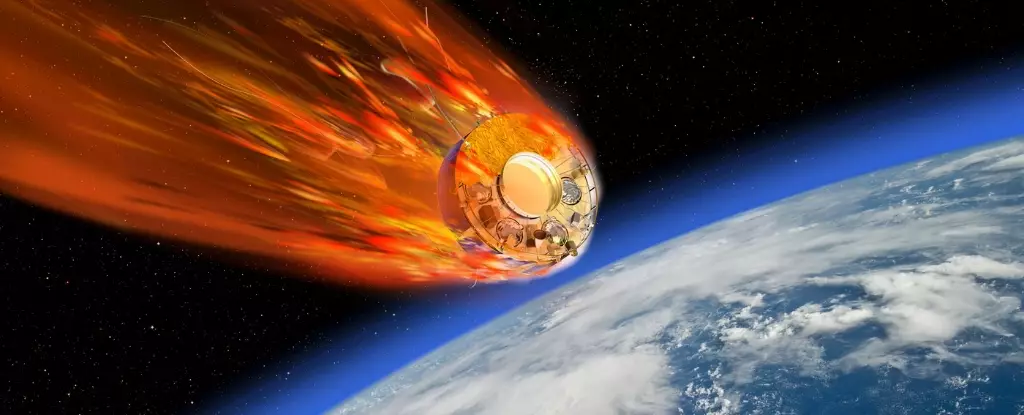During the Cold War, humanity’s reach into space soared, with the USSR leading ambitious missions to explore planets beyond its own. Among these efforts, the Venera program stood out for its audacity and technical innovation. Launched into the fray of space exploration were 29 spacecraft aimed at Venus, known for its hostile environment yet often dubbed Earth’s twin. Among these, Kosmos 482 is a name that perhaps few recognize, but its story intertwines with the greater narrative of human curiosity and competition.
Kosmos 482 is not mere space debris; it embodies the legacy of Soviet science in the search for extraterrestrial life. Officially launched on March 31, 1972, it was intended to accompany Venera 8 to the fiery shores of Venus. However, the spacecraft suffered a failure early on—one that would ensure its place in Earth’s orbit for over half a century. A miscalibrated timer resulted in the premature shutdown of its rocket stage, ultimately leaving its bus stranded in orbit while its landing craft drifted away. This tale of misadventure reminds us how the vaults of space are littered not just with triumphs but also with forgotten relics of human endeavor.
A Glimpse into the Hellish Terrain of Venus
The Venera probes were more than mere scientific instruments; they were symbols of ideological hegemony during a period rife with tension and competition between superpowers. Venus, shrouded in dense clouds, was a tantalizing target—promising potential revelations hidden within its unyielding atmosphere. The USSR’s focus on Venus wasn’t simply about exploration; it was also a bold statement about the prowess of socialist science. Each successful landing contributed to a narrative that sought to assert the USSR’s technological superiority over its Western counterpart.
Venera 7, the first spacecraft to soft-land on another planet, opened the floodgates to knowledge about Venus’s infernal climate, characterized by sulfuric acid clouds and crushing atmospheric pressure. Venera 8 continued this momentum, but not without the continued existence of Kosmos 482 as a silent witness to history. As it orbits Earth, the lander of Kosmos 482 remains a testament to both the ambition and the accidents of human exploration.
The Science of Reentry: A Dance with Destiny
As Kosmos 482 approaches its predicted reentry date, the scientific community watches with a mix of anticipation and anxiety. The spacecraft is equipped with a titanium structure designed to withstand the unbearable conditions of Venus, where temperatures can soar to 470°C and pressures can reach up to 90 atmospheres. However, the lander will lack its refrigeration system and aerobraking technology that served it so well in its original mission to Venus. Now, it faces an uncontrolled reentry into Earth’s atmosphere, a process fraught with peril.
A typical spacecraft reenters at speeds around seven kilometers per second, exposing it to extreme temperatures that can reach up to 1,600°C. The titanium used in the structure has a melting point of approximately 1,700°C. This dubious dance with fate could easily end in disintegration, or it could lead to an unexpected survival, much like other “space balls” that have defied the odds and landed in unexpected locales. Should Kosmos 482 survive the descent, it would transform from a curious artifact of Soviet ambition into a modern relic with an indelible story etched in the annals of space exploration.
Reflections of Pop Culture: The Mystique of Venus
The narrative surrounding Venus extends beyond scientific achievements; it permeates popular culture, revealing societal fears and anxieties of various eras. From East German films that projected hostile extraterrestrial life intent on conquering Earth, to more contemporary narratives questioning the implications of space exploration on our environment, Venus serves as a rich canvas for imagination. This dichotomy—visionary exploration juxtaposed with dystopian outcomes—mirrors the conflicting sentiments that define humanity’s quest for knowledge and mastery beyond its terrestrial home.
Such representations reflect not only Cold War fears but also modern concerns over the environment, specifically the escalating issue of space debris. While the fate of Kosmos 482 may capture our interest, it also brings forth a critical conversation about the increasing amount of junk orbiting Earth and its potential impacts on global ecology. As numerous satellites are launched, each one adds to the ‘debris field,’ sparking worries over contamination and collisions.
The legacy of Kosmos 482 is thus twofold: a story of historic achievement interwoven with the tangled perceptions of an era rife with paranoia. As it descends toward its destiny or demise, it commands a unique space in both our scientific heritage and our cultural psyche, leaving us to ponder the true cost of exploration.


Leave a Reply